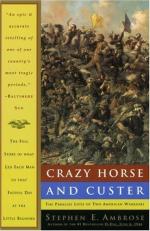
|
| Name: _________________________ | Period: ___________________ |
This test consists of 15 multiple choice questions and 5 short answer questions.
Multiple Choice Questions
1. What are the Lance Owners?
(a) A Sioux society.
(b) A tribal nickname.
(c) Elders.
(d) Cheyenne warriors.
2. Who was the half-French, half-Iowa interpreter used by the soldiers at Fort Laramie in Chapter 4?
(a) Conquering Bear.
(b) Brule.
(c) Wyuse.
(d) Francois.
3. At age ten, Custer went to live with his half-sister and her new husband who lived in __________.
(a) Columbus, Ohio.
(b) Boston, Massachusettes.
(c) Yorktown, Indiana.
(d) Monroe, Michigan.
4. What was the most important subject at West Point when Custer attended?
(a) Science.
(b) Military strategy.
(c) Oration.
(d) Math.
5. How did Custer spend his teenager years according to Chapter 7?
(a) Going to school.
(b) Playing practical jokes.
(c) Trying to do something and be somebody.
(d) Competing against others.
6. When did Custer become a Major General?
(a) July, 1863.
(b) September, 1864.
(c) January, 1865.
(d) May, 1864.
7. How much did the leather cap that West Point cadets were required to wear weigh?
(a) Five pounds.
(b) Three pounds.
(c) Six pounds.
(d) One pound.
8. Who was mortally wounded from Custer's charge against the Confederates at Yellow Tavern?
(a) Robert E. Lee.
(b) Jeb Stuart.
(c) Phil Sheridan.
(d) Wesley Merritt.
9. In Chapter 3, what aspect of Sioux life would Claude Levi-Strauss, a French anthropologist, have called the "science of the concrete"?
(a) Visions.
(b) Storytelling.
(c) Hunting.
(d) Animals as teachers.
10. What did the Oglalas call the road that the settlers knew as "The Oregon Trail"?
(a) The White Man's Road.
(b) Laramie Trail.
(c) The Solder's Trail.
(d) The Holy Road.
11. In 1854, who owned the trading house near Fort Laramie?
(a) Jim Bordeaux.
(b) Henry Hawk.
(c) John Grattan.
(d) Francis Parkman.
12. Ohio's population in the 1800s is called a young population by the author. Why?
(a) 73 percent were under thirty years of age.
(b) 55 percent were under twenty years of age.
(c) White Americans had just moved to Ohio.
(d) 62 percent were under twenty-five.
13. What was the estimated number of buffalo on the Great Plains in the nineteenth century?
(a) 2.5 million.
(b) 25 million.
(c) 750,000.
(d) 75 million.
14. In Chapter 10, who says, "it looks like treason" about a document?
(a) Captain Custer.
(b) General McClellan.
(c) General Smith.
(d) Fernando Wood.
15. Who did Custer meet on Thanksgiving evening in 1862?
(a) Elizabeth Bacon.
(b) Mary Holland.
(c) Fanny Fifield.
(d) Issac Christiancy.
Short Answer Questions
1. What book led to Custer writing an essay titled, "The Red Man" while at West Point?
2. In Chapter 7, what wars are cited as wars that Custer taught about?
3. At what age did most Sioux boys participate in their first tribal hunt?
4. What event occurred on February 9, 1864?
5. Who says, "Crazy Horse always led his men himself when they went into battle, and he kept well in front of them"?
|
This section contains 446 words (approx. 2 pages at 300 words per page) |

|




